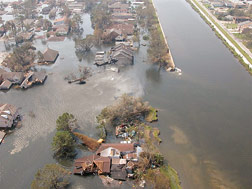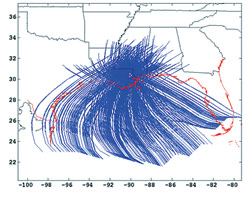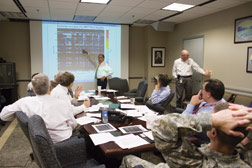proceed on a separate track. The draft release of that work, called the “Decision Chronology Report,” is expected in a few weeks. But in the fall of 2005, the Corps quickly needed meaningful, credible design guidance based on the performance of the system. The final draft report had to be finished before the next hurricane season began, setting a nine-month deadline for the IPET team.
 Ed Link
|
 Ed Link Link adores cold-regions research and the chance to innovate, such as modifying a Bobcat to carve square-section tunnels at the South Pole.
|
Link accepted the job of directing the project with only a moment’s hesitation. The geologist and former civilian lab director for the Corps had specialized in camouflage, cold- regions research and laboratory organization. He retired in 2001 to academic life at the University of Maryland and consulting from his ultimate post as the Corps’ director of research and development and chief scientific adviser. Launching IPET, he quickly assembled more than 150 eminent scientists and experts, half from the Corps and half from other government agencies, academia and private industry. They, in turn, were supported by hundreds of others.
The experts came from a slew of disciplines and divided the inquest into 10 initial focus areas, with leaders and teams for each. Link was challenged to integrate developing data before the teams had findings. Information that each discipline was accumulating often laid the foundation for analysis by others. That massive effort needed a leader with a Renaissance feel for evaluating disparate knowledge, a penchant for seeing the larger picture in a blizzard of information and a genius for managing people.
Link’s selection for the role “was such a good choice,” says David Daniel, president of the University of Texas, Dallas, and a member of the National Academy of Engineers. “Ed did a remarkable job.”
Daniel saw it up close, as chairman of an external review panel convened by the American Society of Civil Engineers at the Corps’ request. Its mission was to provide an ongoing and concurrent, yet independent review of IPET’s plans, policies, progress and results. Rather than wait until the project was finished and submit the finished report for outside review, Link’s teams internally integrated their data and findings, exchanged them for cross-discipline review and exposed preliminary findings to the panel members as fast as they could reasonably be established. Panel participants fired criticisms and recommendations right back. In many cases, Link adjusted the project’s course in response.
Such simultaneous efforts also expedited IPET’s design guidance, even at incremental stages of the investigation.
Link “had a hugely complex task to try to lead a disparate group from all over the country in an intensive effort under the microscope of public scrutiny for an agency that clearly had made some mistakes,” Daniel says. The Corps made a “brilliant” decision in picking a leader from outside who nevertheless knew how the Corps functions, he adds. “Had they not, it would have been an almost impossible situation,” he says.
 Ed Link Army engineers honors in 2002.
|
“In the way that he ran the meetings, [Link] was clearly and substantially distanced but deeply knowledgeable about the Corps,” Daniel says. “He was always saying, ‘We have to develop the facts in an open and fair way and let the cards fall where they may.’ ”
Daniel points out that, “to the team’s credit, I think we have a shockingly accurate picture of what went wrong. It was IPET’s work that made that possible,” Daniel says. Study participants “made it clear the Corps played it too close to the margins and used out-of-date survey data intentionally. They laid it all out there in an open book and now we understand what happened,” he says.
IPET’s success is no surprise to Warren Grabau, former chief of the Corps’ Mobility and Environmental Division at the old Waterways Experiment station in Vicksburg, Miss., today’s Engineering Research and Development Center. Grabau retired in 1985 but remains one of Link’s mentors and is deeply impressed by IPET’s organization and his colleague’s approach to problem solving. “It is the first time I have ever heard of a research or investigatory effort being organized that way. It’s a remarkable achievement,” Grabau says.
 Michael Goodman/ENR Models validate computed wave behavior.
|
From the start, Link saw that every aspect of system performance was affected by a host of factors and forces that had to be examined holistically, Grabau says. “The traditional method would have been to put the hydraulic engineer on the problem of that wave going over the dike,” he says. “But [Link] saw that this also had to be related to the subsurface’s effect on the wave and the air pressure’s effect on the waves.”
According to Grabau, “the research structure was based on that concept, and that’s why the continual review of the components of the report and the continual reviews outside the disciplines were so valuable. [Link] saw the entire problem [and] did not see individual problems of a levee failing or waves overtopping or anything else. He saw them all as interplayers that interacted instantaneously and continuously over time.” Grabau adds, “I think this is new. I hope it is recognized for what it is.”
Final Results
The IPET report also is undergoing traditionally paced, independent review by the National Research Council. The nine-volume, 6,000-page study, which was released in draft form last June, has continued to grow with additions in response to suggestions.
The document’s final version is just now being released incrementally. Its first six volumes were cleared by the U.S. Dept. of Justice for publication on March 26. They include an executive summary; regional geodetic and water-level data; Hurricane Katrina’s form, winds, waves and surge; the drainage and pumping system and the flooding’s consequences.
The document’s remaining volumes deal with the performance of the hurricane protection system, the analysis of the levees and floodwalls and a presentation of the risk evaluation methodology.
 Army Corps of Engineers Understanding why some levees failed and others did not is critical for strong repair. Mapping risk will be key to reducing it.
|
One of IPET’s early findings was a realization that an incredible amount of science was required. Forensic experts had to dig through the Katrina destruction to analyze system failures from the remains. The system itself would have to be reconstructed as data, and grounded in truth before analysis could really begin.
The elevation data upon which significant past construction was based was faulty, and deteriorating further with subsidence. Virtually no meteorological instruments in the path of the storm had survived, and most of the damaged floodwalls and levees had been swept or eroded away.
| + click to enlarge |
 IPET Study
|
But the modeling of the hurricane and its storm surge got off to a fast start. The National Oceanic and Atmospheric Administration worked with the team to build the initial modeling data. Using a supercomputer at the Corps’ center in Vicksburg, the investigators quickly added higher resolution to the model and layered it with a far more refined analysis of contributing factors than any hurricane model before.
Modeling for Success
Researchers modeled the development of the wind field and storm surge from the moment Katrina entered the Gulf of Mexico until the day after landfall. They modeled the coastal geography, sea bottom, marshes, channels, canals and levees. Participants computed and timed the loading effects of the encounter between rising waters and rushing waves and the flood defense structures. They also broke down the system into 150 reaches of similar condition and construction, as well as modeling the structural resilience of 375 transitions, pumps and gates.
 IPET Study
|
 Michael Goodman/ENR Science predicts hazard probability and system performance better than historical data, Link says.
|
In the process, researchers realized the fallacy of modeling the system against the experience of any particular set of historical storms. Even Katrina is by no means the apex of the hazard New Orleans may someday face. If planners were to devise a truly robust system, they would need a more valid basis for the hazard than the worst storm in memory. In order to truly model the range of hazards that needed to be taken into consideration, they required the worst storm nature could generate under the laws of physics. Also needed was a whole range of storms coming at the city from a fan of directions.
In the end, Link says they decided they could do the job properly by modeling 152 storms. “We started out with 2,000 but realized that because the worst storms share certain patterns, we could narrow it down to that many,” Link says.
Now, rather than simply modeling Katrina, the scientists have a suite of potentially deadly storms tracking across the city. They also have a highly refined model of the flood defenses as they existed when Katrina roared in. It includes “fragility curves” for each element, predicting how much loading each can stand before it fails. Researchers are refining another version of how the rebuilt system stands today, and yet another of how it will be when raised to the authorized 100-year protection levels in 2010.
 Tom Sawyer/ENR System risk and reliability data can be shown in many ways. Link explains one to Corps.
|
The resulting risk and reliability model is “the mother of all spreadsheets,” says Link. It can deliver predictions concerning the probability of flooding, refined down to the census tract, from accumulated rainfall, levee overtopping or failure. Findings can also be couched in terms of probable loss of life, given various population levels and effectiveness of evacuation. The scientists now are talking to New Orleans civic and business leaders, as well as Corps leaders. They are striving to find the most effective and useful formats for the risk and reliability information so policymakers and planners can understand and communicate the hard realities of risk to the broader population.
For Ed Link, the IPET challenge was the latest in a career full of them. Over the years he rose through a succession of leadership positions, organizing and running Corps research laboratories. His most significant late-career project included research and development on measures to harden the Pentagon, in Washington, D.C., against attack. Following the terrorist assaults of Sept. 11, 2001, he managed performance evaluation of the portion of the building that had been modified according to the previous specifications.
Link’s post-retirement professional plans, broken by the IPET project, include a position as senior research engineer at the Dept. of Civil and Environmental Engineering at the University of Maryland, College Park. He also does...



Post a comment to this article
Report Abusive Comment